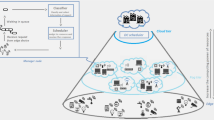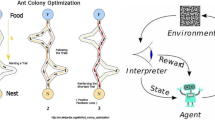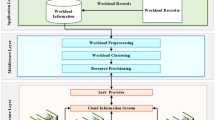Abstract
Mobile cloud computing (MCC) broadens the mobile devices capability by offloading tasks to the ‘cloud’. Hence, offloading numerous tasks simultaneously increases the ‘cloudlets’ load and augments the average completion duration of the offloaded tasks. To withstand this issue, we propose a hybrid Queue Ant Colony-Artificial Bee Colony Optimization (Ant-Bee) algorithm for optimal assignment of tasks in MCC environment. The proposed algorithm works on a two-way MCC model with offloading technique, that considers of both the ‘cloudlets’ and the public ‘cloud’. The ‘cloud’ and the ‘cloudlets’ are designed on the basis of queue model for the estimation of clients waiting time in the limitation of resources. The major concern of the proposed algorithm is to offload the tasks by identifying the accurate place preferably in a ‘cloud/cloudlet’. The ‘cloud/cloudlet’ is encompassed by a queue model with the end goal to minimize the drop rate by permitting the tasks to wait in the queue. It also aims for the optimal assignment of tasks to manage the ‘cloudlets’ load and to minimize the entire tasks average completion time. The performance of the proposed algorithm is analyzed with few Queue based conventional algorithms such as, “Round Robin”, “Weighted Round Robin” and “Random”. From the simulation result, it is analyzed that our proposed algorithm outperforms in the power consumption of the mobile devices, the average completion time of tasks, and drop rate. Also, to ensure the efficiency of our proposed hybrid QAnt-Bee algorithm, it is contrasted with the “HACAS” application scheduling algorithm, which fails to consider queue in the ‘cloudlets’.














Similar content being viewed by others
References
Dinh, H. T., Lee, C., Niyato, D., & Wang, P. (2013). A survey of mobile cloud computing: Architecture, applications, and approaches. Wireless Communications and Mobile Computing, 13(18), 1587–1611.
Chen, M., Wu, Y., & Vasilakos, A. V. (2014). Advances in mobile cloud computing. Mobile Networks and Applications, 19(2), 131–132.
Binitha, S., & Sathya, S. S. (2012). A survey of bio inspired optimization algorithms. International Journal of Soft Computing and Engineering (IJSCE), 2(2), 2231–2307.
Ahmed, E., Gani, A., Khan, M. K., Buyya, R., & Khan, S. U. (2015). Seamless application execution in mobile cloud computing: Motivation, taxonomy, and open challenges. Journal of Network and Computer Applications, 52, 154–172.
Ahmed, E., Gani, A., Sookhak, M., Hamid, S. H. A., & Xia, F. (2015). Application optimization in mobile cloud computing: Motivation, taxonomies, and open challenges. Journal of Network and Computer Applications, 52, 52–68.
Vinu Sundararaj, Selvi Muthukumar, & Kumar, R. S. (2018). An optimal cluster formation based energy efficient dynamic scheduling hybrid MAC protocol for heavy traffic load in wireless sensor networks. Computers & Security, 77, 277–288.
Achary, R., Vityanathan, V., Raj, P., & Nagarajan, S. (2015). Dynamic job scheduling using ant colony optimization for mobile cloud computing. Intelligent Distributed Computing Advances in Intelligent Systems and Computing, 321, 71–82.
Chunlin, L., & LaYuan, L. (2015). Cost and energy aware service provisioning for mobile client in cloud computing environment. The Journal of Supercomputing, 71(4), 1196–1223.
Vilaplana, J., Solsona, F., Teixidó, I., Mateo, J., Abella, F., & Rius, J. (2014). A queuing theory model for cloud computing. Journal of Supercomputing, 69(1), 492–507.
Ramakrishnan, B., Selvi, M., & Bhagavath Nishanth, R. (2015). Efficiency measure of routing protocols in vehicular ad hoc network using freeway mobility model. Wireless Networks, 23(2), 323–333.
Xie, J., Dan, L., Yin, L., Sun, Z., & Xiao, Y. (2015). An energy-optimal scheduling for collaborative execution in mobile cloud computing. In 2015 international conference and workshop on computing and communication (IEMCON) (pp. 1–6). IEEE.
Rong, P., & Pedram, M. (2006). Power-aware scheduling and dynamic voltage setting for tasks running on a hard real-time system. In Asia and South Pacific conference on design automation (p. 6). IEEE.
Feller, E., Rilling, L., & Morin. C. (2011). Energy-aware ant colony based workload placement in clouds. In Proceedings of the 2011 IEEE/ACM 12th international conference on grid computing (pp. 26–33). IEEE Computer Society.
Zhang, W., Wen, Y., & Wu, D. (2013). Energy-efficient scheduling policy for collaborative execution in mobile cloud computing. In 2013 Proceedings IEEE INFOCOM (pp. 190–194). IEEE.
Zhang, W., & Wen, Y. (2015). Cloud-assisted collaborative execution for mobile applications with general task topology. In 2015 IEEE international conference on communications (ICC) (pp. 6815–6821). IEEE.
Giurgiu, I., Riva, O., Juric, D., Krivulev, I., & Alonso, G. (2009). Calling the cloud: Enabling mobile phones as interfaces to cloud applications. In ACM/IFIP/USENIX international conference on distributed systems platforms and open distributed processing (pp. 83–102). Springer.
Wu, H., Wang, Q., & Wolter, K. (2013). Tradeoff between performance improvement and energy saving in mobile cloud offloading systems. In 2013 IEEE international conference on communications workshops (ICC) (pp. 728–732). IEEE.
Lee, Y. C., & Zomaya, A. Y. (2009). Minimizing energy consumption for precedence-constrained applications using dynamic voltage scaling. In 9th IEEE/ACM international symposium on cluster computing and the grid. CCGRID’09 (pp. 92–99). IEEE.
Lin, X., Wang, Y., Xie, Q., & Pedram, M. (2014). Energy and performance-aware task scheduling in a mobile cloud computing environment. In 2014 IEEE 7th international conference on cloud computing (pp. 192–199). IEEE.
Van den Bossche, R., Vanmechelen, K., & Broeckhove, J. (2010). Cost optimal scheduling in hybrid iaas clouds for deadline constrained workloads. In 2010 IEEE 3rd international conference on cloud computing (pp. 228–235). IEEE.
Tayal, S. (2011). Tasks scheduling optimization for the cloud computing systems. IJAEST-International Journal of Advanced Engineering Sciences and Technologies, 1(5), 111–115.
Xu, B., Peng, Z., Xiao, F., Gates, A. M., & Yu, J.-P. (2015). Dynamic deployment of virtual machines in cloud computing using multi-objective optimization. Soft Computing, 19(8), 2265–2273.
Altamimi, M., Abdrabou, A., Naik, K., & Nayak, A. (2015). Energy cost models of smartphones for task. IEEE Transactions Emerging Topics in Computing, 3(3), 384–398.
Sundararaj, V. (2017). Optimized denoising scheme via opposition based self-adaptive learning PSO algorithm for wavelet based ECG signal noise reduction. International Journal of Biomedical Engineering and Technology, 1(1), 1.
Sundararaj, V. (2016). An efficient threshold prediction scheme for wavelet based ECG signal noise reduction using variable step size firefly algorithm. International Journal of Intelligent Engineering and Systems, 9(3), 117–126.
Wei, X., Fan, J., Lu, Z., & Ding, K. (2013). Application scheduling in mobile cloud computing with load balancing. Journal of Applied Mathematics. https://doi.org/10.1155/2013/409539.
Arlitt, M. F., & Williamson, C. L. (1996). Web server workload characterization: The search for invariants. In Proceedings of the 1996 ACM SIGMETRICS international conference on measurement and modeling of computer systems, New York, NY, USA.
Author information
Authors and Affiliations
Corresponding author
Additional information
Publisher's Note
Springer Nature remains neutral with regard to jurisdictional claims in published maps and institutional affiliations.
Rights and permissions
About this article
Cite this article
Sundararaj, V. Optimal Task Assignment in Mobile Cloud Computing by Queue Based Ant-Bee Algorithm. Wireless Pers Commun 104, 173–197 (2019). https://doi.org/10.1007/s11277-018-6014-9
Published:
Issue Date:
DOI: https://doi.org/10.1007/s11277-018-6014-9




